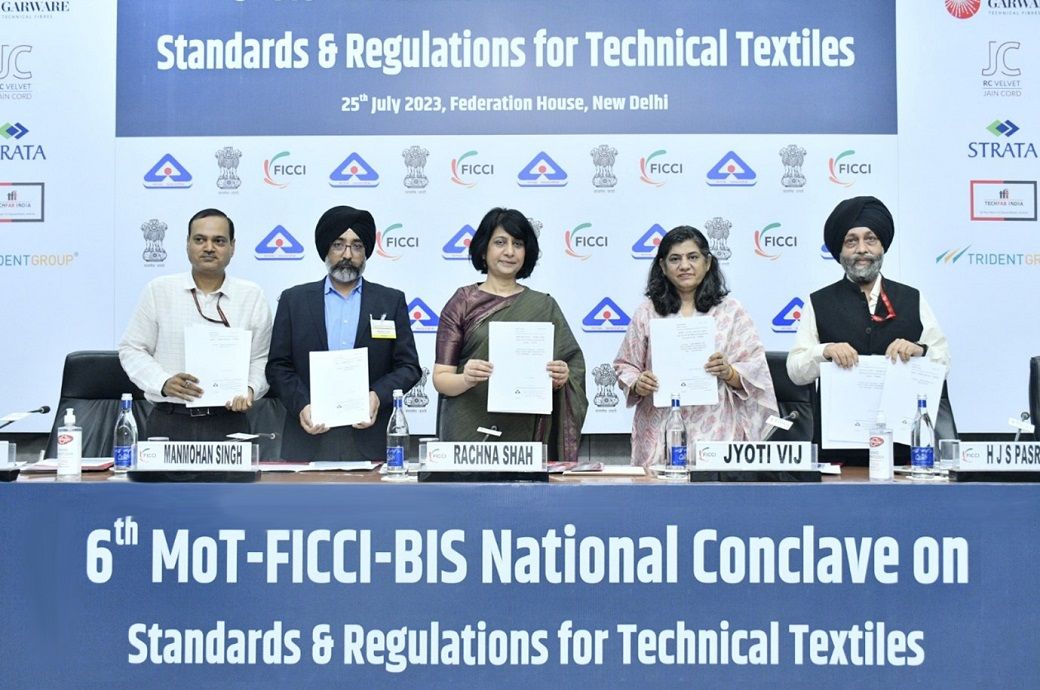
The standards introduced at the conclave were IS 18266 : 2023, Textiles — Medical Respirator — Specification; IS 18309 : 2023 Geosynthetics — Prefabricated Vertical Drains for Quick Consolidation of Very Soft Plastic Soil — Specification; IS 18158 : 2023 Textile — Floor Covering - Artificial Grass Carpet made of Synthetic Yarn for Landscape — Specification; and IS 18161 : 2023, Textiles — Light Weight Jute Sacking Bags for Packing 50 kg Mustard Seed, Niger Seed and Ragi — Specification.
The event encompassed five technical sessions focusing on standards and regulations under specialised areas of technical textiles like protective textiles, geotextiles, build tech, oekotech, medical textiles, and in other emerging areas of technical textiles. There was a special session also discussing rationalisation of HSN codes and standards and implementation of Quality Control Orders (QCOs).
Addressing the conclave, Rachna Shah, secretary, ministry of textiles, stated that within the textile sector, the technical textile segment has in recent years shown robust growth, both internationally and in the domestic market. “The global technical textiles market is around $260 billion and is expected to increase to $325 billion by 2025-26. Within India, the market size is around $22 billion, and the goal of the government is to take it to $40-50 billion over the next five years,” she emphasised.
She opined that to amplify the production of technical textile products, it is imperative to map them with the relevant HSN codes which will facilitate the streamlining of trade tracking and alignment with the HSN mapping requirements. These steps will also support effective implementation of flagship schemes of the ministry of textiles like the Pradhan Mantri Mega Integrated Textile Region and Apparel (PM MITRA), Production Linked Incentive (PLI) Scheme, etc.
Shah added that the export of technical textiles presently is $2.5 billion, and the government’s objective is to enhance it to $10 billion during this period. A collaborative approach between certification agencies, research organisations, industry, academia, and ministry is imperative to work together in the identification of gaps and meeting the standardisation needs for the growth of the sector.
Rajeev Saxena, joint secretary, ministry of textiles, emphasised the importance of effective implementation of QCOs and introduction of new standards for technical textiles, especially in consonance with global standards, while setting the context for the conclave. Further, 32 new technical textiles’ HSN codes have been notified in April 2023, beyond the list of already notified 207 HSN Codes, he added. He also highlighted that a Technical Committee for Rationalisation of HSN Codes for technical textiles has already been formed.
Regarding the release of new QCOs, Saxena mentioned that two QCOs for 31 technical textile items under geotextiles and protective textiles were notified and will come in effect from October 7, 2023. In addition, the ministry has also undertaken the task to notify QCOs for 56 technical textile items including 22 agro textiles, six medical textiles, among others.
He opined that QCOs are vital for ensuring specified standards of quality, safety, and reliability of products in technical textiles. The ministry has embarked on the journey to implement QCOs in technical textiles in a phased manner.
Moreover, he urged the industry to recommend for any need for new QCOs, development of new product specifications standards, rationalisation of existing HSN Codes, and introduction of new HSN Codes for technical textiles, among others.
HJS Pasricha, scientist - F and deputy director general–certification and CSMD, BIS, stated that the textiles division of BIS has published more than 1,500 standards for textiles, out of which about 600 standards are for the technical textiles and its test methods.
“It is a sunrise segment, and standardisation plays a key role in technical textiles. To fast-track the process of standardisation, BIS has constituted a specialised committee in 12 segments of technical textiles. Implementation of standards is crucial in increasing the production and imports of substandard products along with promoting safety at large,” he added.
To fast-track the process of releasing standards, BIS is maintaining the P membership on the Textiles (ISO/TC 38), Textiles machinery (ISO/TC 72), Geosynthetics (ISO/TC 221), Menstrual products ISO/TC 338, Personal safety (ISO/TC 94) committees, and its sub committees at ISO and is taking extensive process reforms to enhance the participation of Indian experts at the ISO/IEC level by taking a leadership role in various ISO/IEC technical committees, subcommittees, panels, and working groups.
Manmohan Singh, co-chair of the FICCI-Textiles and Technical Textiles Committee, highlighted that there is huge potential in the country for technical textiles both for investments and consumption. It is vital to understand and establish robust standards and regulations that foster growth and ensure quality and safety.
Fibre2Fashion News Desk (NB)

